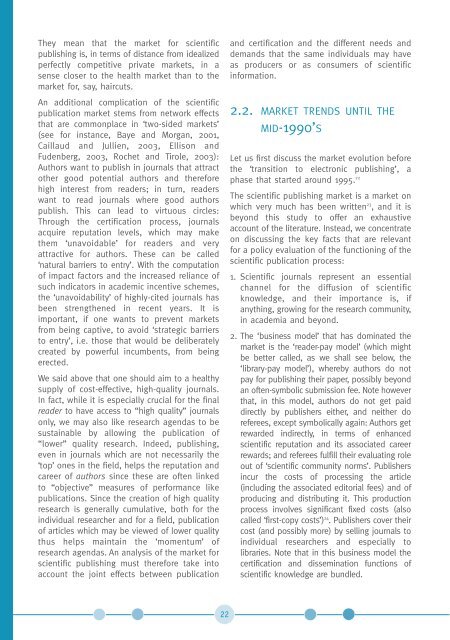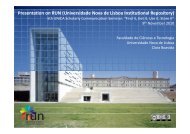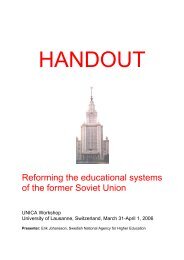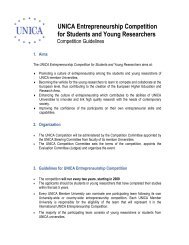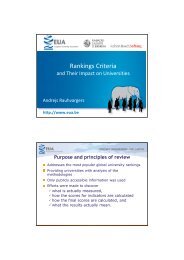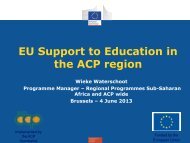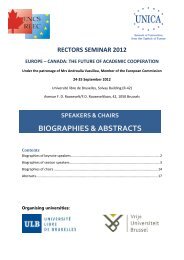Study on the economic and technical evolution of the scientific ...
Study on the economic and technical evolution of the scientific ...
Study on the economic and technical evolution of the scientific ...
You also want an ePaper? Increase the reach of your titles
YUMPU automatically turns print PDFs into web optimized ePapers that Google loves.
They mean that <strong>the</strong> market for <strong>scientific</strong><br />
publishing is, in terms <strong>of</strong> distance from idealized<br />
perfectly competitive private markets, in a<br />
sense closer to <strong>the</strong> health market than to <strong>the</strong><br />
market for, say, haircuts.<br />
An additi<strong>on</strong>al complicati<strong>on</strong> <strong>of</strong> <strong>the</strong> <strong>scientific</strong><br />
publicati<strong>on</strong> market stems from network effects<br />
that are comm<strong>on</strong>place in ‘two-sided markets’<br />
(see for instance, Baye <strong>and</strong> Morgan, 2001,<br />
Caillaud <strong>and</strong> Jullien, 2003, Ellis<strong>on</strong> <strong>and</strong><br />
Fudenberg, 2003, Rochet <strong>and</strong> Tirole, 2003):<br />
Authors want to publish in journals that attract<br />
o<strong>the</strong>r good potential authors <strong>and</strong> <strong>the</strong>refore<br />
high interest from readers; in turn, readers<br />
want to read journals where good authors<br />
publish. This can lead to virtuous circles:<br />
Through <strong>the</strong> certificati<strong>on</strong> process, journals<br />
acquire reputati<strong>on</strong> levels, which may make<br />
<strong>the</strong>m ‘unavoidable’ for readers <strong>and</strong> very<br />
attractive for authors. These can be called<br />
‘natural barriers to entry’. With <strong>the</strong> computati<strong>on</strong><br />
<strong>of</strong> impact factors <strong>and</strong> <strong>the</strong> increased reliance <strong>of</strong><br />
such indicators in academic incentive schemes,<br />
<strong>the</strong> ‘unavoidability’ <strong>of</strong> highly-cited journals has<br />
been streng<strong>the</strong>ned in recent years. It is<br />
important, if <strong>on</strong>e wants to prevent markets<br />
from being captive, to avoid ‘strategic barriers<br />
to entry’, i.e. those that would be deliberately<br />
created by powerful incumbents, from being<br />
erected.<br />
We said above that <strong>on</strong>e should aim to a healthy<br />
supply <strong>of</strong> cost-effective, high-quality journals.<br />
In fact, while it is especially crucial for <strong>the</strong> final<br />
reader to have access to “high quality” journals<br />
<strong>on</strong>ly, we may also like research agendas to be<br />
sustainable by allowing <strong>the</strong> publicati<strong>on</strong> <strong>of</strong><br />
“lower” quality research. Indeed, publishing,<br />
even in journals which are not necessarily <strong>the</strong><br />
‘top’ <strong>on</strong>es in <strong>the</strong> field, helps <strong>the</strong> reputati<strong>on</strong> <strong>and</strong><br />
career <strong>of</strong> authors since <strong>the</strong>se are <strong>of</strong>ten linked<br />
to “objective” measures <strong>of</strong> performance like<br />
publicati<strong>on</strong>s. Since <strong>the</strong> creati<strong>on</strong> <strong>of</strong> high quality<br />
research is generally cumulative, both for <strong>the</strong><br />
individual researcher <strong>and</strong> for a field, publicati<strong>on</strong><br />
<strong>of</strong> articles which may be viewed <strong>of</strong> lower quality<br />
thus helps maintain <strong>the</strong> ‘momentum’ <strong>of</strong><br />
research agendas. An analysis <strong>of</strong> <strong>the</strong> market for<br />
<strong>scientific</strong> publishing must <strong>the</strong>refore take into<br />
account <strong>the</strong> joint effects between publicati<strong>on</strong><br />
<strong>and</strong> certificati<strong>on</strong> <strong>and</strong> <strong>the</strong> different needs <strong>and</strong><br />
dem<strong>and</strong>s that <strong>the</strong> same individuals may have<br />
as producers or as c<strong>on</strong>sumers <strong>of</strong> <strong>scientific</strong><br />
informati<strong>on</strong>.<br />
2.2. MARKET TRENDS UNTIL THE<br />
MID-1990’S<br />
Let us first discuss <strong>the</strong> market evoluti<strong>on</strong> before<br />
<strong>the</strong> ‘transiti<strong>on</strong> to electr<strong>on</strong>ic publishing’, a<br />
phase that started around 1995. 22<br />
The <strong>scientific</strong> publishing market is a market <strong>on</strong><br />
which very much has been written 23 , <strong>and</strong> it is<br />
bey<strong>on</strong>d this study to <strong>of</strong>fer an exhaustive<br />
account <strong>of</strong> <strong>the</strong> literature. Instead, we c<strong>on</strong>centrate<br />
<strong>on</strong> discussing <strong>the</strong> key facts that are relevant<br />
for a policy evaluati<strong>on</strong> <strong>of</strong> <strong>the</strong> functi<strong>on</strong>ing <strong>of</strong> <strong>the</strong><br />
<strong>scientific</strong> publicati<strong>on</strong> process:<br />
1. Scientific journals represent an essential<br />
channel for <strong>the</strong> diffusi<strong>on</strong> <strong>of</strong> <strong>scientific</strong><br />
knowledge, <strong>and</strong> <strong>the</strong>ir importance is, if<br />
anything, growing for <strong>the</strong> research community,<br />
in academia <strong>and</strong> bey<strong>on</strong>d.<br />
2. The ‘business model’ that has dominated <strong>the</strong><br />
market is <strong>the</strong> ‘reader-pay model’ (which might<br />
be better called, as we shall see below, <strong>the</strong><br />
‘library-pay model’), whereby authors do not<br />
pay for publishing <strong>the</strong>ir paper, possibly bey<strong>on</strong>d<br />
an <strong>of</strong>ten-symbolic submissi<strong>on</strong> fee. Note however<br />
that, in this model, authors do not get paid<br />
directly by publishers ei<strong>the</strong>r, <strong>and</strong> nei<strong>the</strong>r do<br />
referees, except symbolically again: Authors get<br />
rewarded indirectly, in terms <strong>of</strong> enhanced<br />
<strong>scientific</strong> reputati<strong>on</strong> <strong>and</strong> its associated career<br />
rewards; <strong>and</strong> referees fulfill <strong>the</strong>ir evaluating role<br />
out <strong>of</strong> ‘<strong>scientific</strong> community norms’. Publishers<br />
incur <strong>the</strong> costs <strong>of</strong> processing <strong>the</strong> article<br />
(including <strong>the</strong> associated editorial fees) <strong>and</strong> <strong>of</strong><br />
producing <strong>and</strong> distributing it. This producti<strong>on</strong><br />
process involves significant fixed costs (also<br />
called ‘first-copy costs’) 24 . Publishers cover <strong>the</strong>ir<br />
cost (<strong>and</strong> possibly more) by selling journals to<br />
individual researchers <strong>and</strong> especially to<br />
libraries. Note that in this business model <strong>the</strong><br />
certificati<strong>on</strong> <strong>and</strong> disseminati<strong>on</strong> functi<strong>on</strong>s <strong>of</strong><br />
<strong>scientific</strong> knowledge are bundled.<br />
22


